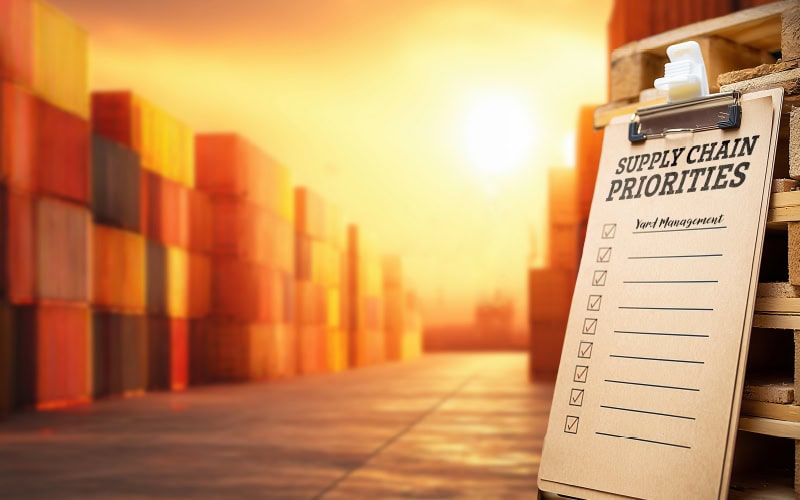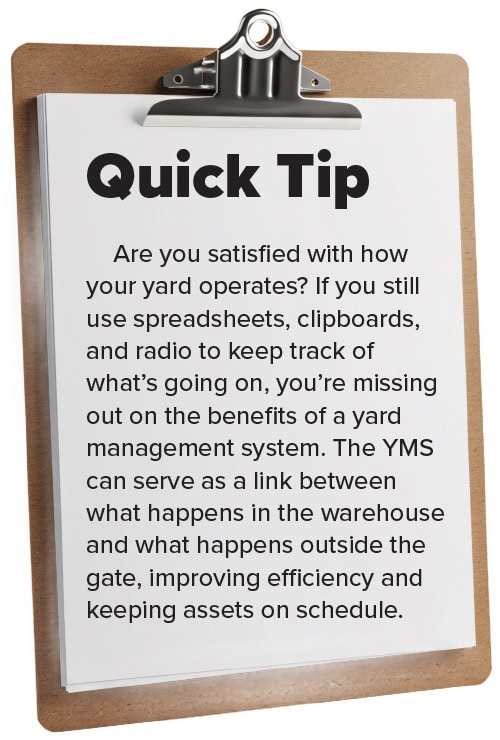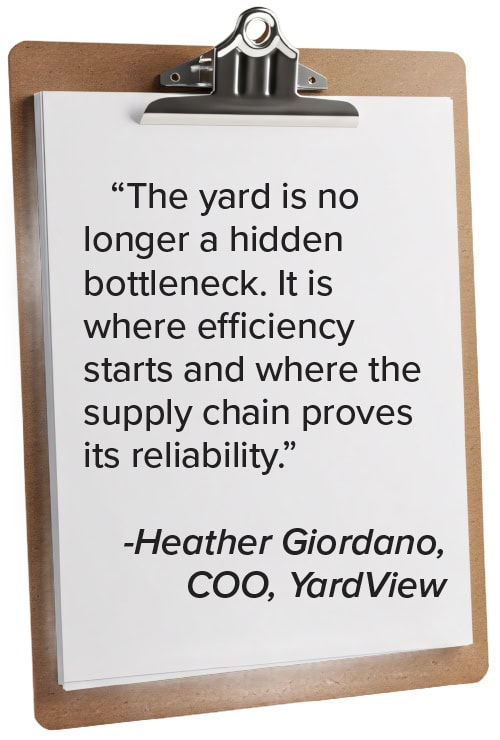Putting the Yard First: Why Supply Chain Efficiency Starts Here

The right yard management system can transform your entire supply chain. It can reduce labor costs, streamline operations, improve utilization of yard assets, and yes, increase supply chain efficiency.
 As supply chains face labor shortages, shifting volumes, and rising customer expectations, the yard is becoming one of the most overlooked yet essential points of control.
As supply chains face labor shortages, shifting volumes, and rising customer expectations, the yard is becoming one of the most overlooked yet essential points of control.
Historically, yards have been one of the last places businesses invest in technology, often still governed by paperwork, phone calls, physical office visits, and basic yard management system platforms that merely digitize paper processes.
YardView COO Heather Giordano believes that “putting the yard first” is more than a phrase; it represents a practical strategy for supply chain resilience.
“Putting the yard first means recognizing it as the key to operational flow,” Giordano says. “When yard, warehouse, and transportation teams are aligned through a unified system, companies gain measurable efficiency and stronger supply chain performance.”
The signs of underperformance in yard operations are often subtle. Prolonged trailer dwell times, congestion, and recurring misloads can creep into daily operations without an apparent cause. Short-term fixes may help, but Giordano notes they rarely deliver sustained improvement.
“Efficient trailer and container management keeps docks, warehouses, and transportation in sync,” she says. “That alignment reduces bottlenecks and drives higher throughput.”
A yard management system, or YMS, is a software solution designed to monitor the movement of trailers in the yard and dock of a facility, distribution center, or warehouse.
The YMS coordinates all yard activities that happen between the gate and the dock door. Its primary purpose is to coordinate, schedule, and direct assets—such as inbound and outbound trucks, trailers, shipments, personnel, and more—within a facility’s dock and yard.
As supply chain complexity and velocity continue to increase, using manual methods or outdated tools slows down your yard, leading to higher costs, mistakes, and a lack of visibility needed for data-driven decision-making.
The “put the yard first” philosophy has driven innovation by identifying significant opportunities to infuse automation through connecting supply chain and warehouse information signals. These connections inform on-the-ground operations and create more fluid end-to-end processes, notes Stephen Dyke, principal solution advisor at FourKites.
“For example, when ETAs for inbound trucks are automatically compared to their appointment times, AI can intelligently reschedule time slots to avoid misses and delays, eliminating manual coordination and preventing bottlenecks before they occur,” Dyke says.
In today’s yard, a robust YMS is a key tool for management and optimization. Increasing operational costs, detention charges, and other disruptions present opportunities for yard management to improve operational efficiency via increased visibility and process optimization.
Implementing a YMS can address rising operational costs and detention charges, which are signals that there is room for improvement through increased visibility and process optimization.
Yard management technology is often overlooked compared to warehouse or transportation management systems; it plays a critical role in streamlining operations between the two.
Limited YMS functionality may be a feature from some WMS providers or as a third-party application from an independent vendor. The YMS can be the fulcrum to unify warehouse and transportation yard management systems to deliver substantial operational and financial benefits.
A YMS can transform your yard from a source of frustration into a competitive advantage for cost savings and supply chain visibility.
Here are exclusive insights from some leading YMS providers that offer solutions incorporating the latest technological advances to help drive efficiency and service innovations to meet ongoing supply chain challenges.
FourKites YMS: Connecting All Corners of the Supply Chain
Yard operations serve as the critical connection point between warehouse operations and transportation networks, requiring the ability to balance well-thought-out plans with seamless adaptation to delays and congestion in the warehouse. Success requires a single execution platform that correlates real-time arrival ETAs with warehouse capacity and yard conditions, enabling synchronized operations across the entire supply chain.
Many companies use trailers in the yard as cost-effective storage—cheaper than leasing additional warehouse capacity. When inventory sits in yard trailers, it’s critical that this inventory remains visible and that principles such as first-in, first-out (FIFO) can be executed across WMS, ERP planning systems, and yard operations.
By eliminating blind spots between warehouse and transportation systems through AI-powered automation, efficient yard operations reduce detention costs, improve dock utilization, and enable better inventory management.
“This represents one of the best opportunities for meaningful return on investment—a critical reason to act given the yard’s role as the pacing item in the cash-to-available cycle,” says Dyke at FourKites.
Identifying Red Flags
How do you know it’s time for a better yard management system? There will be signs, Dyke notes.
Key indicators of dock underperformance include high team turnover and unplanned overtime caused by appointments running longer than scheduled. Missed appointments also have an impact, as high driver dwell times ripple through the entire operation.
Another red flag is difficulty understanding which dock doors are available or about to be freed up, leading to inefficient resource allocation.
“Short-term solutions can address delays at dock doors by segregating doors by product type, while longer-term solutions can optimize schedules based on real-world timing with a unified platform,” Dyke says.
Enabling a Seamless Flow of Information
A yard management system should create seamless information flow between transportation management systems and warehouse management systems. Integration should enable automatic updates—when a trailer arrives (identified through computer vision or sensors), the scheduling system confirms the appointment, and the warehouse management system gets updated automatically. Automated processes eliminate manual handoffs and phone calls.
“The integration should also leverage real-time transportation visibility data to anticipate arrivals and adjust yard priorities dynamically based on actual ETAs rather than scheduled times,” Dyke says.
Yielding Measurable Results
Recent FourKites Dynamic Yard deployments highlight the value of putting the yard first.
Kimberly-Clark fully digitized its yard orchestration and reduced detention fees by 52%—a $448,000 savings—and reduced the number of trailers entering detention by 20%. Even more exciting, Kimberly-Clark achieved these impressive results in just 30 days.
“We can set up the shipping coordinators to know when a trailer requires immediate attention with alerts that allow them to be more proactive in avoiding detention altogether,” says Taylor Rotella, strategy and analytics manager, Kimberly-Clark.
Facing $2.69 million in annual detention charges, building technology and energy solutions company Trane discovered its sites were completely unaware of the problem—ocean containers were parked everywhere, including on streets outside facilities, while site teams focused solely on their individual metrics rather than total supply chain cost.
The solution connected real-time visibility to appointment scheduling and yard management, enabling Trane to match inbound container arrivals with dray carrier plans and dock appointments in advance.
This proactive approach enabled them to maintain a consistent flow across their network and relocate containers from high-cost port storage to no-cost alternatives during demand spikes.
The results exceeded expectations: Trane eliminated nearly all of its $2.69 million in detention costs, achieving payback in months, what Tom France, VP of Logistics and Distribution, called “the highest payback we’ve had on any type of visibility-related solution.”
The success led to enterprise-wide deployment across their entire distribution network.
YardView YMS: Real-Time Visibility, Full Control, and Lasting Efficiency
 YardView COO Heather Giordano views an effective YMS as the most effective long-term solution. Modern platforms go well beyond scheduling or gate control, offering real-time visibility, data accuracy, and seamless integrations with warehouse and transportation systems.
YardView COO Heather Giordano views an effective YMS as the most effective long-term solution. Modern platforms go well beyond scheduling or gate control, offering real-time visibility, data accuracy, and seamless integrations with warehouse and transportation systems.
“Companies need flexible, data-driven operations for faster decision making, real-time visibility for full control, and robust scheduling to stay ahead of disruptions,” she says.
She emphasizes that some of the most impactful YMS capabilities are also the most overlooked. Movement data tracking and automated exception alerts can reduce errors, optimize labor, and improve trailer turnaround times. Labor-intensive tasks such as trailer searches and appointment scheduling can be automated entirely. YardView YMS also captures data transactionally, recording every change to ensure accuracy.
“When workflows are automated and integrated across systems, teams can make faster, more reliable decisions,” Giordano explains.
Technology, however, should not dictate the process. The most successful implementations are those where technology adapts to real-world yard workflows, she says.
“The most rewarding feedback is measurable efficiency improvements. The most constructive comes from customers asking for enhancements that help us innovate,” Giordano notes.
Leveraging AI
Artificial intelligence and automation are increasingly transforming yard management. YardView incorporates AI to automate move assignments, optimize dock scheduling, and recommend the next best move. These advances point to a shift toward predictive logistics, where bottlenecks are anticipated and resolved before they occur.
“We combine automation and AI with human oversight and seamless integrations to reduce manual tasks, improve throughput, and enable smarter operational decisions,” Giordano says.
As supply chains grow more complex, Giordano believes the yard will continue to gain visibility as a strategic hub.
“The yard is no longer a hidden bottleneck. It is where efficiency starts and where the supply chain proves its reliability,” she says.
As much as technology matters, Giordano emphasizes that partnership is what drives long-term success. “Every yard operates differently, which is why we focus on scalable, customized solutions delivered quickly at a fair cost,” she says. YardView also backs its platform with expert 24/7 U.S.-based support, ensuring customers have help when they need it.
“At the end of the day, our role is to be a trusted partner in building efficiency and resilience into yard operations,” Giordano says.
Best-In-Class YMS Capabilities
YARD VISIBILITY: Full yard visibility into all inbound and outbound processes unifies warehouse and transportation management functions and goals.
WAREHOUSE-TO-TRAILER-CONTROL: Optimized control featuring trailer prioritization and dock door assignments.
REAL-TIME INSIGHTS: Active data flow with the ability to track the location and status of all assets in the yard.
UNIFIED WMS/TMS: Sync transportation and warehouse activities and appointment management for seamless moves.
AUTOMATION EFFICIENCY: Automated processes for maximum yard efficiency.
SAFETY NOTIFICATIONS: Enhance safety with real-time notifications for yard hazards and effectively manage yard personnel for optimal labor utilization.
REPORTING AND ANALYTICS: Reporting and analytics that highlight areas where the yard is performing well and areas that need improvement.
ADVANCED TECHNOLOGY: User-specific applications for different roles (dock workers, spotters, gate guards) and computer vision capabilities that eliminate the need for expensive RFID infrastructure.
YMS Leaders
FourKites
www.fourkites.com
FourKites’ Intelligent Control Tower™ and AI-powered system of Digital Workers can transform end-to-end execution capabilities. YardWorks AI integrates yard operations with the FourKites’ Intelligent Control Tower, eliminating traditional blind spots between warehouse and transportation networks and replacing manual processes with AI-driven automation.
YardView
www.yardview.com
YardView’s cloud-based yard management solutions provide real-time visibility, seamless communication, and full operational control. Built for collaboration across departments, YardView helps companies maximize dock and asset utilization, reduce dwell time, improve on-time performance, optimize throughput, and eliminate costly delays.
